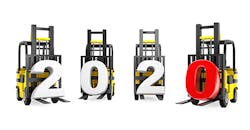Five New Year’s Resolutions for your Forklift Fleet
If there is one constant with the start of each new year, it’s the New Year’s resolution. Whether it’s a commitment to be a better person, eat healthier or exercise more, these annual aspirations are designed to focus one’s efforts in the coming year to accomplish a personal goal or break a bad habi
There’s no reason you can’t take this same approach with your forklift fleet. Below are five resolutions for 2020 that could help you enhance the performance of your forklift fleet in the new year.
Adopt a Pragmatic Approach to Connectivity
Given its prominent role in the supply chain in enabling product movement, the forklift provides an ideal starting point for your move toward greater connectivity. It’s important, however, to think about and prioritize what you want to gain from your connected fleet. Take a realistic approach that is based on clear, strategic business objectives and enables you to work toward measurable goals.
There is a wealth of data that can be gathered from forklifts. Focus on a few key operational objectives, such as compliance management or impact detection and reduction. As you make progress and see real ROI, you can move to larger business objectives that revolve around fleet utilization and operator and truck productivity.
Take Control of Your Data
Greater connectivity means greater access to data. A common mistake many companies make when starting with data analytics is a lack of focus. They try to track and gather too much data, and quickly become overwhelmed. Remember, it’s not about how much data you can collect, but rather the type of data and what you do with it.
Identify and prioritize the type of data you will gather and establish a plan and processes to share relevant, timely information with the right departments and individuals at the right time. Make sure the data is presented in a manner that makes it easy to understand and use it to effect real, meaningful operational and behavioral changes.
Reduce Downtime and Mean Time to Repair (MTTR)
Armed with new technology and increased connectivity, tech-savvy service technicians are well-positioned to help make forklift service calls smarter and more proactive. One of the greatest assets these connected service technicians have is the large amount of performance-, operation- and health-related data that greater connectivity allows you to gather on your forklift.
If you’re not already doing so, commit to collecting this actionable information and use it to be more proactive about repairs and recognize symptoms before they become a larger issue. Use it to adequately and efficiently address issues and enhance your service and maintenance program, shortening MTTR and reducing downtime.
Engage Operators in Forklift Safety
A strong safety culture is vital to creating and maintaining a safe working environment. To help achieve and maintain a vibrant safety culture, it is important that managers and supervisors consistently and regularly engage operators in several meaningful ways.
Introduce technology that creates a more informative and personalized experience for operators. Provide real-time feedback to operators that reinforces correct behavior and recognizes incorrect behavior. Competition can be a great way to keep employees engaged and motivated when it comes to safe behavior. Showcasing the exemplary operators and the good choices they make daily will help reinforce expectations.
Take a Strategic Approach with Automation
Technology is evolving quickly to make automated forklifts more practical for use in warehouse and distribution environments. The technology is evolving to the point where it holds real promise to be an integral part of the supply chain. However, as with greater connectivity, it is important that you avoid the hype.
Your effort to introduce forklift automation into your facility should be guided by a realistic plan with realistic expectations. Identify those tasks and equipment that are ideal for automation. Develop a clear path for tangible ROI and determine a process and mechanism for building upon success and strategically growing and evolving your automation efforts.
There is no better time than the beginning of a new year to take a hard look at your forklifts and identify attainable goals that will enhance the performance of your fleet. Whether it’s one or more of these five suggestions or a set of completely different ones, committing to New Year’s resolutions can deliver value to your organization and supply chain.
Craig Bruns is vice president of customer support with forklift manufacturer Crown Equipment.
About the Author
Craig Bruns
vice president-customer support
Craig Bruns is vice president-customer support with Crown Equipment Corp., a manufacturer of forklifts.
